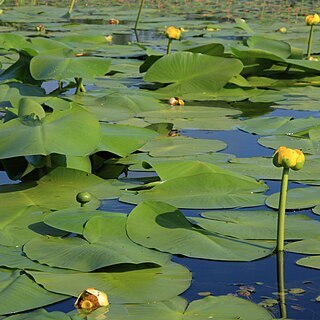Durand Floating lvs 10–25 cm, two-thirds as wide, usually rounded above, the narrow basal sinus seldom over half as long as the midvein; submersed lvs few or none; petioles flattened on the upper side and narrowly winged; fls (2.5)3.5–5 cm thick, sep mostly 6, usually reddish within or on the basal half; anthers 4–7 mm, longer than the filaments; stigmatic disk green or greenish, 1 cm wide, mostly 10–15-rayed; fr ovoid, 2–4.5 cm, only slightly constricted below the disk; 2n=34. Ponds; Nf. to B.C., s. to Del., n. O., Io., Kans., and Ida. Summer. (N. fraterna)
The leaf stalks are slightly flattened with wings. The fruit are purple.

